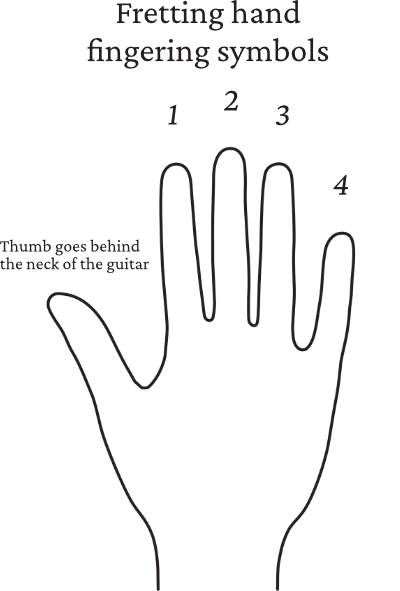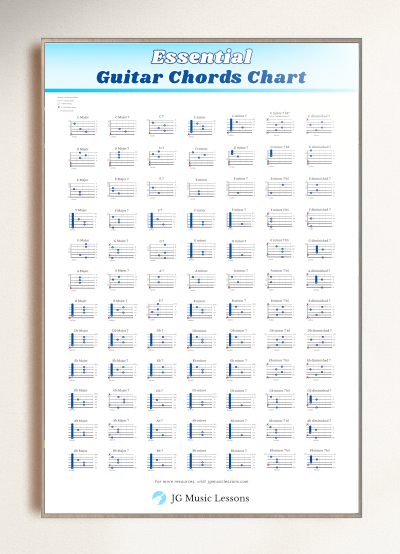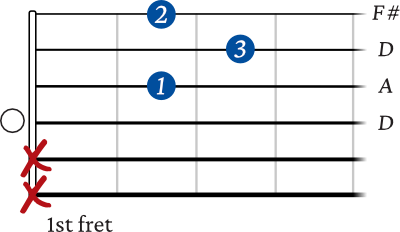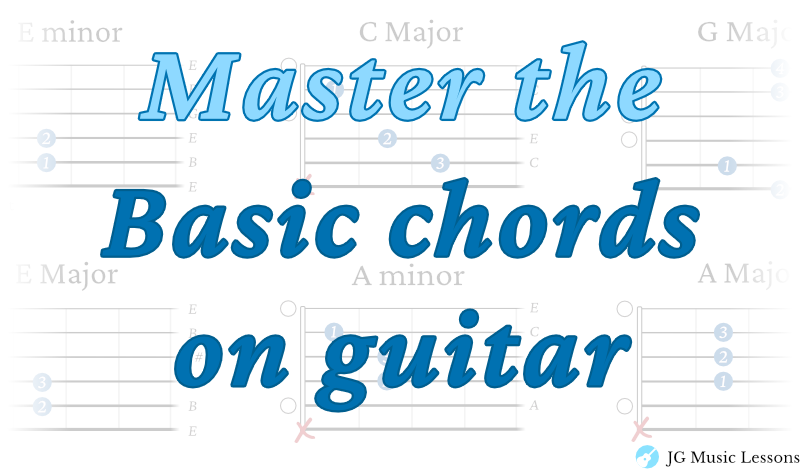Want to learn guitar but not sure where to begin? By focusing on just a few basic chords, you’ll be surprised at how many songs you can start playing. In this guide, you’ll learn the essential guitar chords to kickstart your playing!
In short, the first chords I recommend learning on guitar are E minor, E Major, A minor, A Major, C Major, G Major, D Major, D minor and F Major. All of the chords we’re covering (except for F) are known as open chords because they include one or more open strings that don’t need to be pressed down.
Grab your guitar and let’s get started!
How to read the guitar chord charts
For the charts below:
- The lowest horizontal line represents the thickest string (Low E). The top horizontal line represents the thinnest string (high E).
- The vertical lines represent the frets on the guitar (thin metal lines on your guitar fretboard)
- The numbers inside the circles tell you what fingers to use to press down on your fretting hand (see the fingering chart in the following section)
Take a look at the image below to better understand the chord charts in this lesson.

Fretting hand fingering chart
The chart below shows you what numbers are used to represent your fingers for the fretting hand (the one used to press down on notes).

You can check this link for more on how to read guitar notation symbols.
Now, let’s start going through each guitar chord.
E minor chord
This chord is commonly written as E min or Em in music notation. To play an E minor chord, you can either use your pointer and middle finger or middle and ring finger to press down on the 2nd fret of the 5th and 4th string. Once you have the shape down, you can strum all the strings from lowest to highest string. Here are the two ways to play this chord below:

For the audio of this E minor chord, you will hear the chord being played one string at a time and then all the notes together.
E Major chord
This E Major chord has one extra note added to the previous E minor chord shape. You simply need to add your 1st finger to the 3rd string, 1st fret like this:

Compare how the Major and minor chord sound different. Major chords have a bright sound as opposed to minor chords that have a darker sound.
For more on this chord, check out 12 ways to play an E chord on guitar.
A minor chord
This chord is commonly written as A min or Am in music notation. For this A minor chord, you can simply take the previous E Major chord shape and bring each finger up one string higher. Make sure to strum this chord from the 5th string down, since there is an X on the 6th string here.

For more on this chord, check out 12 ways to play an A minor chord on guitar.
A Major chord
To play this open A Major chord, you play the 2nd fret on the 2nd, 3rd and 4th string. This is an easy shape to remember since the notes are all in a row. You can play this with fingers 1, 2, and 3 or 2, 3, and 4.
Try playing both variations to see which way is more comfortable for you.

For more on this chord, check out 12 ways to play an A chord on guitar.

C Major chord
This chord can be a little trickier to play because you have a wider stretch between your fingers. Fingers 1 and 2 are in the same position as an A minor chord but your 3rd finger will now be placed on the 5th string, 3rd fret like this:

*Tip: Try to keep your fingers slightly arched as you press down on a chord so that you use more of the tip of your fingers to prevent certain strings from accidentally being muted.
For more on this chord, check out 14 ways to play a C chord on guitar.
G Major chord
The G Major chord is unlike the other chord shapes we looked at. This one can also take a little longer to master because of the wide stretch between some of your fingers. Here is what the G chord shape looks like:

D Major chord
The D Major chord should be easier to play than the last two chords because the notes that you need to press are close together. For this D chord, you will need to play from the 4th string down, being careful not to play the 5th and 6th string.

For more on this chord, check out 14 ways to play a D chord on guitar.
D minor chord
Lastly, we have the minor version of the previous chord. This is commonly written as D min or Dm chord in music notation. You can keep your 3rd finger in the same position as the D Major but you have to rearrange your 1st and 2nd finger to play this chord. You are essentially just playing the 1st string, 1st fret instead of the 2nd fret.

F Major chord
As I mentioned earlier, this last chord is the only one here that doesn’t use open strings. The first string shows an X here because that would technically make it an F Major 7 chord. Adding the first string may work on some songs but other times you might want to avoid it. Try experimenting and use what sounds best to you.
The second chord option on the right can also be referred to as F/C (F over C).

To learn other chord variations, check out 13 ways to play an F chord on guitar. You can also learn more about slash chords here.
Wrapping up
With just a few basic chords, you can play dozens of songs across many different genres such as pop, rock, or folk music. For example, check out these beginner level songs.
With some time and practice, you’ll also get better at get better at switching between chords.
Once you feel confident playing these chords, try using them with these easy guitar strumming patterns.
A fun way to practice these basic chords is to play them in a series of chords, also called a chord progression. For example, you can try these 7 easy guitar chord progressions to get started.
📘 Get the free guitar practice guide here!
All the best,
JG Music Lessons
📙 Kickstart your guitar playing with our step by step guide: Guitar Essentials.
🎸 Looking for a travel or half-sized guitar? See this one.
🛠 See our other music recommendations.
🤝 Support the site to help us to create better content for you!
Level up with the FREE guitar practice guide and effectively improve your playing! 🎸
Get it sent to your email!



